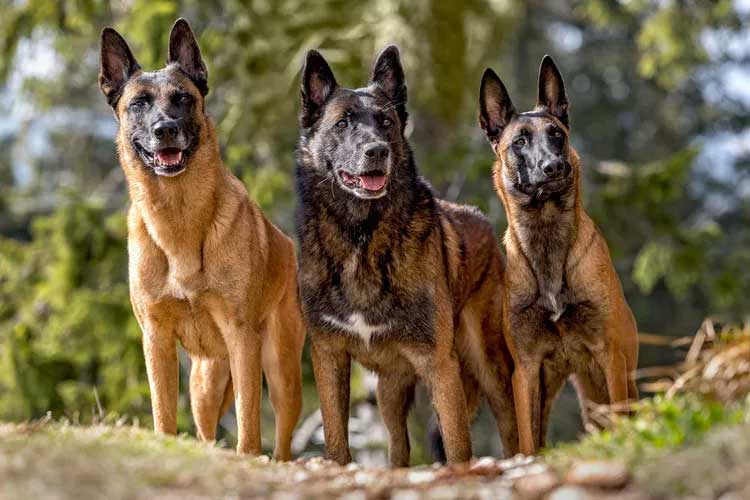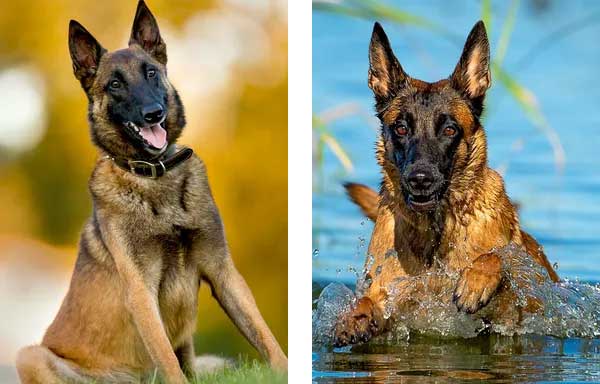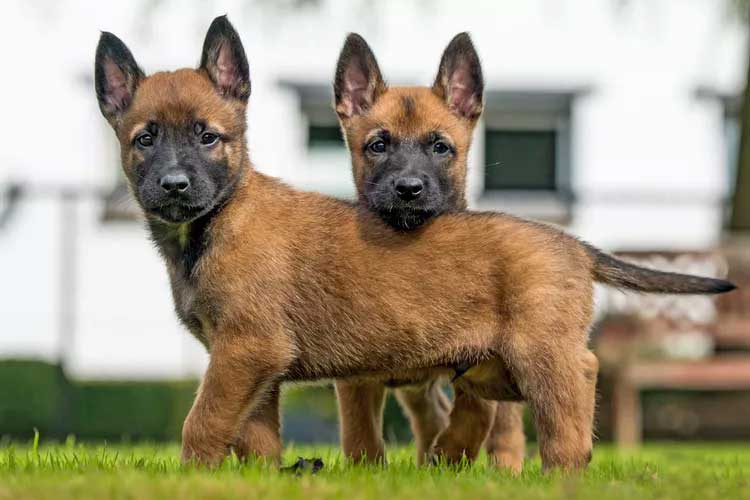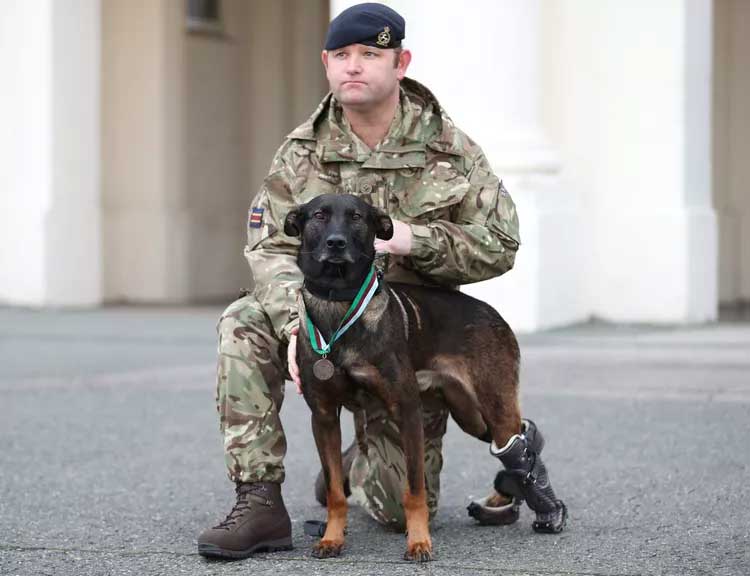The Belgian Malinois (or “Mal” for short) is a high-energy herding breed who loves to put his intelligence and intense focus to work. Learn more about living with Belgian Malinois.

Belgian Malinois Overview
| OFFICIAL NAME | Belgian Malinois |
| COMMON NAME | Belgian Malinois |
| PET HEIGHT | 22 to 24 inches |
| PET WEIGHT | 40 to 80 pounds |
| LIFESPAN | 14 to 16 years |
| GOOD WITH | families |
| TEMPERAMENT | aloof, gentle, playful |
| INTELLIGENCE | high |
| SHEDDING AMOUNT | seasonal |
| EXERCISE NEEDS | high |
| ENERGY LEVEL | hyper |
| VOCAL LEVEL | when necessary |
| DROOL AMOUNT | low |
| BREED GROUP | herding |
| BREED SIZE | large (61-100 lbs.) |
| COAT LENGTH | short |
| COLORS | brown / chocolate / liver, fawn |
| PATTERNS | sable |
| OTHER TRAITS | cold weather tolerant, easy to groom, easy to train, good hiking companion, highly territorial, high prey drive, hot weather tolerant, strong loyalty tendencies |
One of four Belgian herding breeds, the Belgian Malinois—affectionately called the Mal—is a medium-to-large dog with a strong, elegant body. This high-energy breed needs plenty of daily strenuous exercise and mental stimulation, but is otherwise low-maintenance. Revered for their strong work ethic and their smarts, the Balgian Malinois is a top pick for police and military K-9 units. Though more frequently seen on the job than at the park, the Mal's gentle, playful demeanor and loyalty can make him a great family companion.
Appearance
The Belgian Malinois (pronounced MAL-in-wah) is a large herding dog. Bred to work, Mals are packed with powerful muscles, yet their bodies have an elegant appearance. They're tall—up to 2 feet at the shoulders!—and always alert, with perked-up ears; kind, dark chocolate eyes; and a slightly bushy tail. The Mal's thick, short coat comes in shades of fawn to mahogany, and it's common to see a black mask and ears. At a glance, the Mal is often mistaken as a German shepherd. Though they have similar appearances—and both are favorites of police and militaries around the world—these dogs are unrelated, unique breeds.Belgian Malinois weigh between 40–80 pounds, and male Mals are usually bigger than the medium-sized female dogs.

The Malinois' waterproof coat is easy to maintain. Weekly brushing will rid his coat of dead hairs and distribute healthy oils, keeping your Mal looking shiny. This breed does blow his coat twice a year, and during these periods you'll want to keep up with brushing at least once a day, or risk your home being overrun by dog hair. Thanks to their slicking coats, the Belgian Malinois can go a while between baths and, unless they've rolled in something smelly, won't need to be fully bathed more than a few times a year.
Temperament
There's good reason the Belgian Malinois is a favorite among working dogs. With his strong, powerful body and confident demeanor, there isn't much this dog can't accomplish. From working with Navy SEALS to keeping a watchful eye over his family at home, the Mal is a steadfast companion. Extremely loyal and an eager learner, Belgian Malinois take to positive reinforcement training well. As with all dogs, training your Mal is important: Though sweet, sensitive, and deeply devoted, he's an intense dog and will do best in a home with an experienced dog owner."You see a lot of Malinois now used for police work or the army," says Brian Kilcommons, founder of The Great Pets Resort, a training facility in Connecticut. "Those are specifically bred working dogs ... they're certainly not for a novice owner."

Mals are highly energetic dogs with sharp minds and will require lots of daily physical exercise and mental stimulation. Their drive and ceaseless energy levels can become problematic if not properly channeled. Because of their intensity and constant desire to work, Mals are more often employed on a job than kept as a family pet. For decades, Mals have made an excellent choice as search and rescue, bomb and narcotics, and tracking dogs.
The Belgian Malinois are loyal and alert, especially around the humans they love. Early socialization with other people and animals, exposure to different sights and sounds, and positive reinforcement training are a must for a well-rounded Mal.
Bred to herd, Mals might be too much for young children and other pets. If you plan to bring a Mal into a family with existing children or pets, a puppy may be a better choice, as Mals who are introduced at a young age tend to do better. It's important to teach children how to properly interact with dogs and always supervise them when playing with any animal. If you're willing to put in the work, you'll reap big rewards, as Mals are some of the most loyal and loving dogs you can find.
Living Needs
Belgian Malinois were historically bred to herd sheep for hours on end. Though rarely employed as herding dogs today, their stamina remains. Mals require lots of daily outdoor exercise and mental stimulation. Though they can adapt to many living situations—including apartments, if properly exercised—a Mal will be happiest in a home with a large, securely fenced yard to stretch his legs. Malinois enjoy spending time outside, but what they want most is your constant companionship.They form intense bonds with their owners and are happiest accompanying their humans in anything, and everything, they do. This devout loyalty makes Belgian Malinois unsuitable to be alone for long periods of time, and a lonely Mal will likely develop separation anxiety. If not properly exercised or cared for, they can become unhappy and develop undesirable behaviors.

Their sharp intelligence and high energy levels make them a great pick for an active, dedicated owner looking to spend quality time with their dog. If you're looking for a fearless friend to accompany you on long adventures—biking, hiking, and running are great!—the Mal might be a good fit for you. If you're looking for a beautiful dog to simply sit at home with you, adopting a Mal probably isn't a good idea, according to the American Belgian Malinois Club. It's important to consider your lifestyle before committing to any dog. Talk to a Belgian Malinois breeder or rescue group about expectations so you can know if this breed is a good fit for you before you bring home a Belgian Malinois puppy.
Care
Though they have high demands when it comes to exercise, the Belgian Malinois is pretty low-maintenance in terms of grooming, only requiring a quick weekly brushing to control shedding and promote a healthy coat. The Mals do shed seasonally, so you'll want to increase your brushing routine to once a day when their shedding picks up. Their thick, waterproof coat keeps most messes at bay, which means fewer full baths! Unless your Mal enjoys rolling in something smelly, you can go weeks or even months between bathing him.Regular brushing is a good time to check for things like coat sheen (dull hair can mean a lack of nutrients in his diet), nail length, and ear health and dental health. Nails should be trimmed if you can hear them tapping against the floor. Ear canals should be pale pink with very little—and fairly odorless—wax. Be sure to look for any signs of movement (mites!) and foreign objects in the canal, especially if you and your dog spend a lot of time outdoors or have recently been in tall grasses.

It's equally important to care for your dog's mental and emotional needs. Mals need plenty of mental stimulation and social interaction with their owners to be happy and stave off boredom. Consistent training is a great way to bond with your dog, and will be extremely important in shaping a well-rounded, even-tempered Mal.
"Some dogs were bred to work, like the Belgian Malinois," Kilcommons says. "People tend to make training dog-centric, something you do to the dog rather than with the dog. There's a huge differentiation. I train on two things: Relationship and behavior. Because the relationship has to be there in order for the behavior to stick. Be generous with praise and enjoy working with your dog. When you have a relationship, it has to be built on trust and positive experiences and setting boundaries. The relationship comes from spending time doing fun stuff and learning how the dog communicates."
Health
The Belgian Malinois is considered an overall healthy breed with a lifespan of 14–16 years. But like all breeds, the Mal is prone to certain health conditions. The American Belgian Malinois Club, the official breed club, requires registered breeders to test for hip dysplasia, elbow dysplasia, and complete a thorough eye exam. The club also recommends testing for epilepsy and cancer, specifically hemangiosarcoma.Not all Mals will encounter serious health issues, but you should be aware of these common concerns when considering this breed. And it's important to purchase all dogs from reputable breeders who will complete all health tests recommended by the OFA and introduce you to the dog's parents and siblings. If you're adopting a Belgian Malinois, ask the rescue for all available health history.
History
Though the Belgian Malinois may resemble the German shepherd in passing, the breeds are distinct and historically unrelated. Mals were originally bred in northwestern Belgium—near the city of Malines, hence the name—where this strong, intelligent breed was prized for its hard-working character and employed to herd sheep and cattle. Back then, all four Belgian shepherd varieties (Malinois, Tervuren, Laekenois, and Groenendael) were typically lumped into one breed.According to the ABMC, Mals were one of the first Belgian shepherd dogs brought to the U.S. (they immigrated in 1911), and experienced a long streak of popularity until the outbreak of World War II, which paused the European imports. The Belgian shepherd dogs were officially registered by the AKC as separate breeds in 1959, and the Mal saw a resurgence in interest—though it fell behind the three other Belgian shepherds in popularity.

Belgian Malinois have often been used in the military and were used as message carriers, ambulance dogs, and to pull machine guns in World War I, according to the ABMC. In fact, the breed is so revered for its service that a memorial to military dogs in Fayetteville, North Carolina, features a life-size statue of a Mal.
More recently, and perhaps most famously, a Mal named Cairo assisted Seal Team Six in the 2011 raid that killed terrorist Osama Bin Laden. Today, the breed is a sought-after working dog, from herding and protecting livestock to serving alongside policemen—they're more in-demand for these roles than even German shepherds. With their gentle, playful demeanor and strong loyal tendencies, modern Mals also make great family pets. As of 2020, the Belgian Malinois is the AKC's 41st most popular breed.
Fun Facts
The Belgian Malinois is one of the fastest breeds in the world—it has been clocked to run up to 30 mph.Mals performed important jobs in World War I, such as carrying messages, pulling ambulance carts, and assisting the Red Cross.
In John Wick: Chapter 3 – Parabellum, Halle Berry didn't just portray a character who commanded a pair of canine soldiers, she actually became a dog trainer, bonding with and training the five Belgian Malinois used during filming.
Belgian Malinois like to have a job to do, but sometimes it's hard to channel their enthusiasm. Like with Ryker, a trainee at the Double H Canine Training Academy. He bombed his service dog test in hilarious fashion and is still a very good boy.